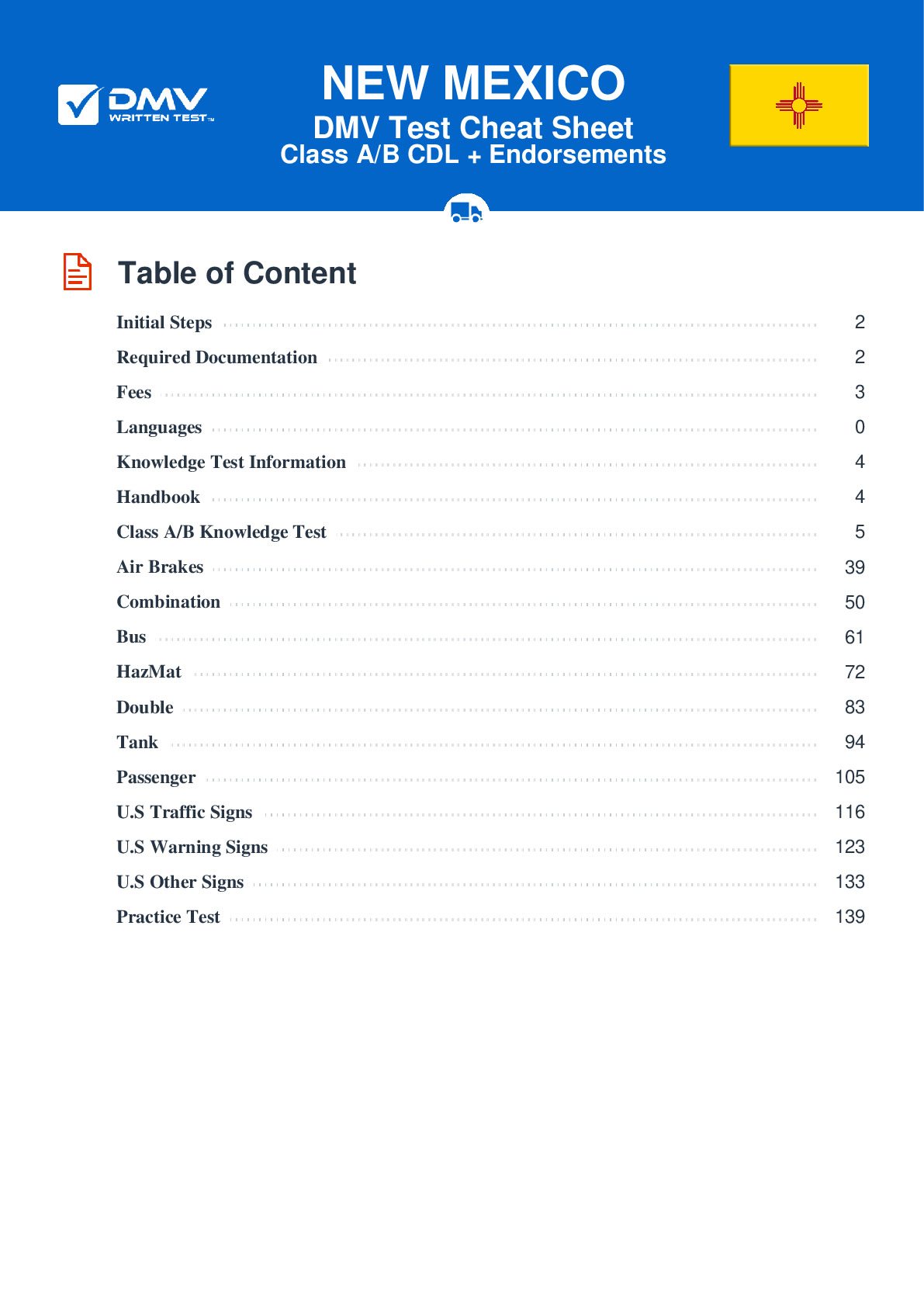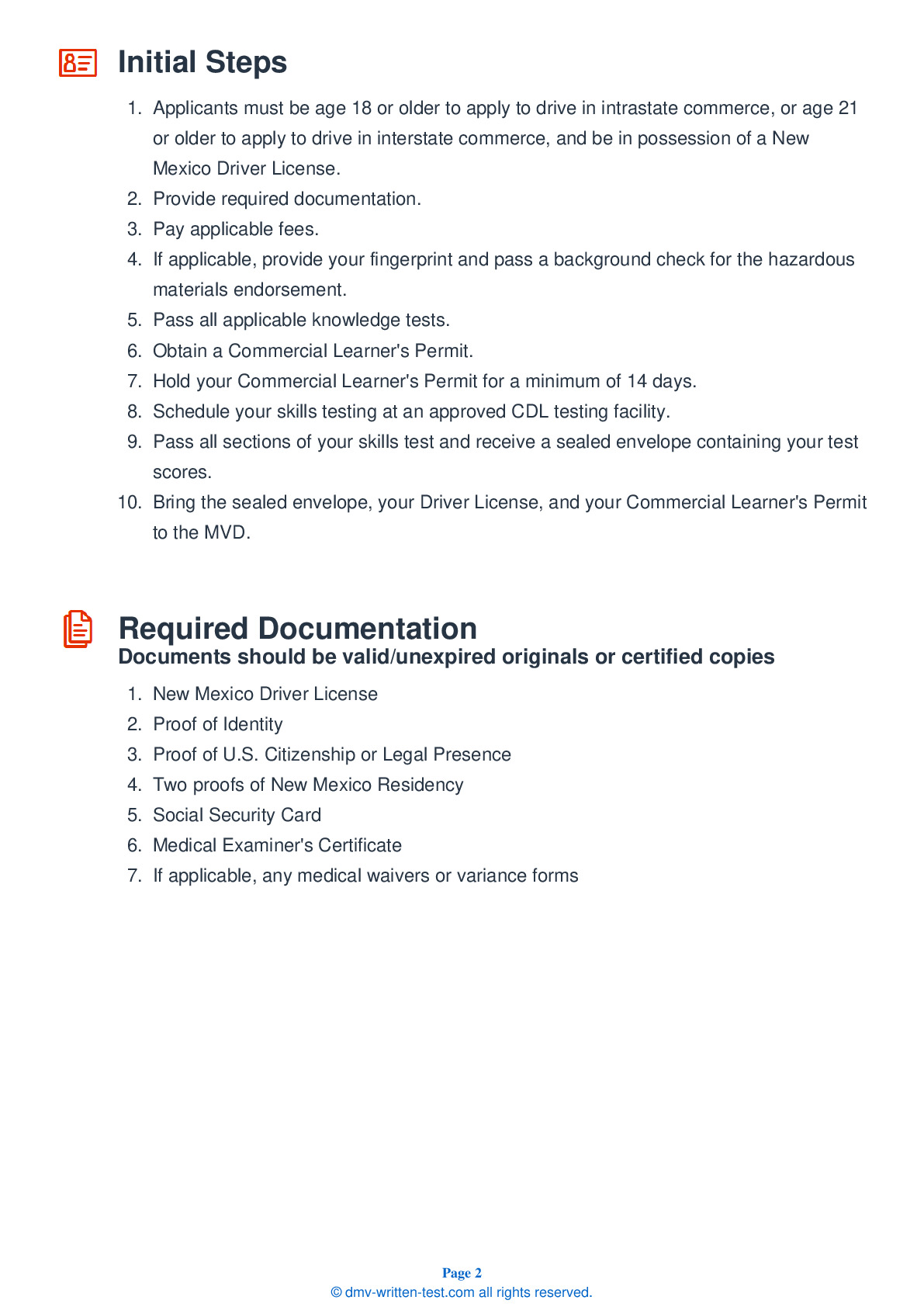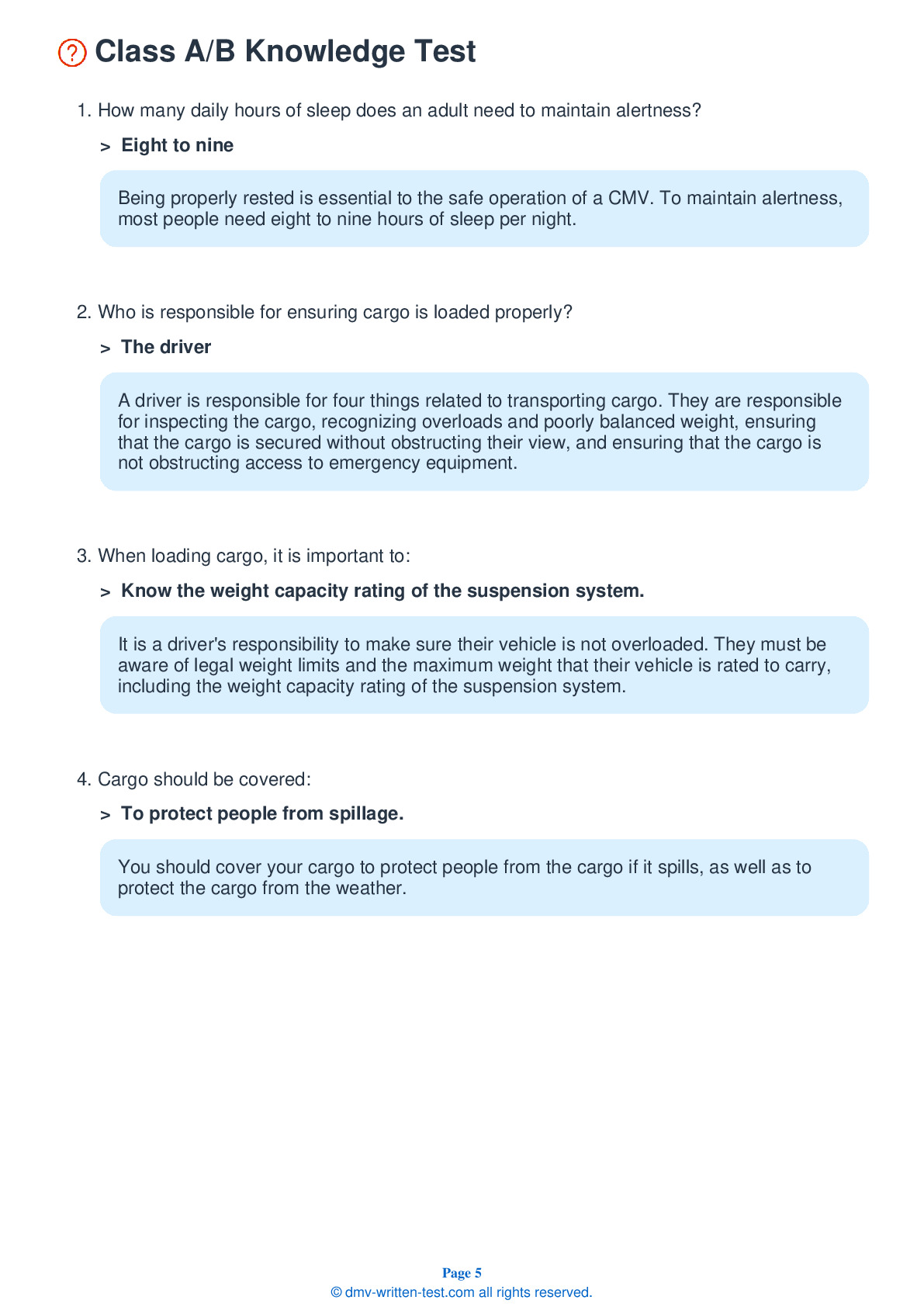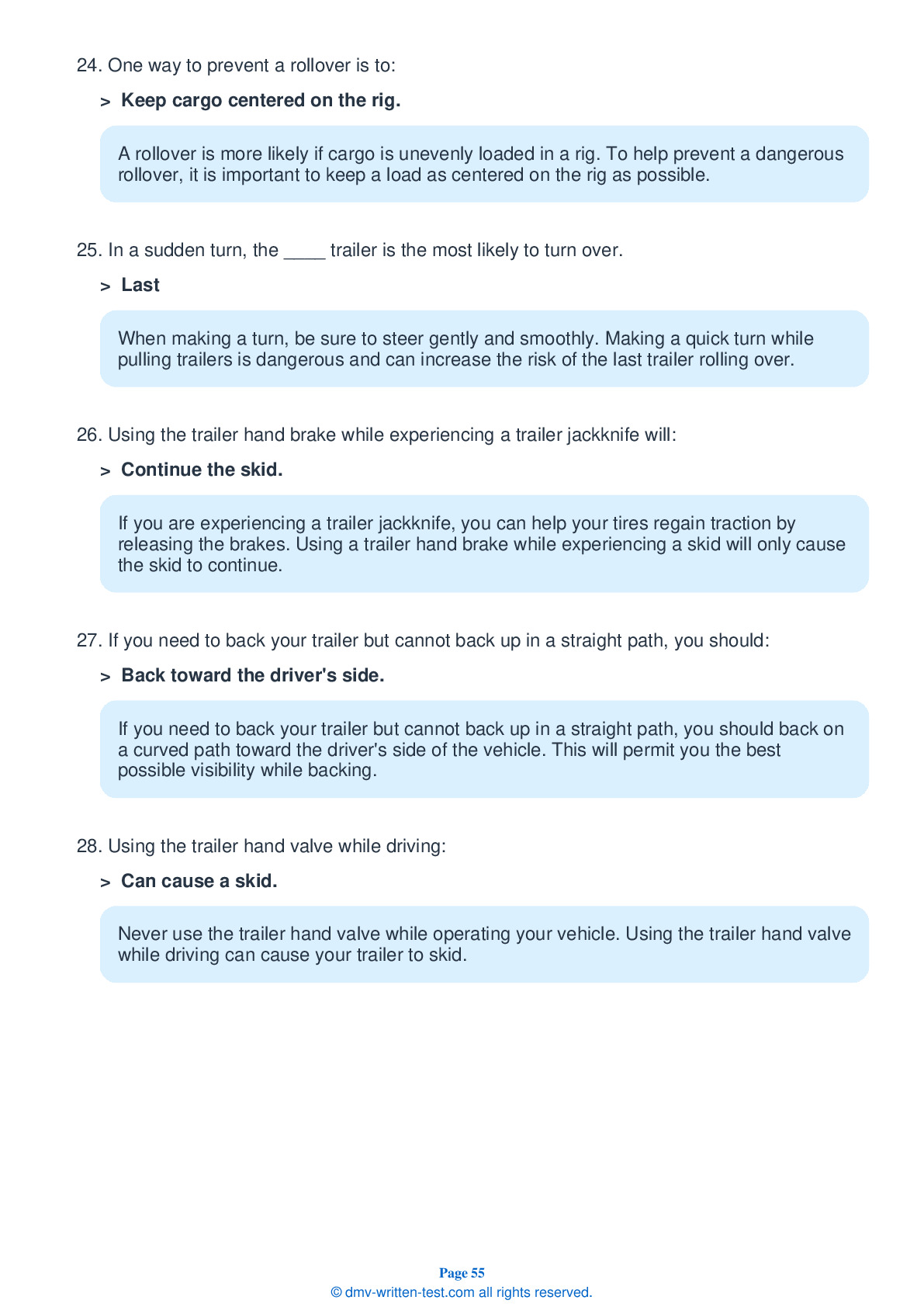Double
This endorsement is required if the driver will pull two or three trailers. To receive this endorsement, applicants must pass a test. The test consists of 20 multiple choice questions. To pass, the applicant must answer at least 16 questions correctly. Each question has three possible answer choices. Test questions come from the New Mexico Commercial Driver License Manual. Questions come from chapters covering: Driving Safely, Air Brakes (if applicable), Combination Vehicles and Doubles and Triples. The Double/Triple endorsement can be used with the Class A CDL.
Number of Question
Passing Score
1. If a truck is equipped, a trailer brake hand valve can be used to:
Explanation
If a tractor-trailer is so equipped, the trailer brake hand valve can be used to stop the vehicle from rolling back when being started from a stop.
2. After a tire has been changed, the driver should stop after a short distance to:
Explanation
After changing a tire, you should stop a short distance later to recheck the tightness of the tire's lug nuts.
3. If the brakes pull to one side or the other when used:
Explanation
If the brakes pull to one side or the other when used, it is an indication of brake trouble.
4. When driving on packed snow, you should reduce your speed by:
Explanation
Reduce your speed when traveling on surfaces that provide reduced traction. Reduce your speed by one-half or more when traveling on packed snow.
5. To make it easier to leave a parked position, you should park:
Explanation
Backing is always dangerous and should be avoided whenever possible. When parking, look to park in a space that will allow you to pull forward when exiting.
6. Once cargo is secured onto a vehicle:
Explanation
The securement of cargo must be checked before beginning a trip, within the first 50 miles of a trip, and then again every three hours or 150 miles thereafter.
7. During an inspection, slack adjusters on S-cam brakes should not move more than:
Explanation
Check each slack adjuster after parking on level ground, setting wheel chocks, and disengaging the parking brake. Pull the slack adjusters to make sure they do not move more than about one inch from where the push rod is attached. If they move more than one inch, they may be out of adjustment and will need to be fixed.
Frequently Asked Questions
To obtain a CDL Doubles/Triples endorsement in New Mexico, you must follow these steps:
1. Obtain a New Mexico commercial driver's license (CDL).
2. Complete a CDL Doubles/Triples endorsement application form and pay the required fee.
3. Pass the doubles/triples written knowledge test. You must score at least 80% to pass.
4. Take a doubles/triples skills test, which includes a pre-trip inspection, basic control skills test, and on-road driving test.
5. If you pass the skills test, the examiner will issue you a CDL Doubles/Triples endorsement.
Note: Before taking the doubles/triples skills test, you must already have a valid New Mexico CDL and have completed training with a commercial driving school or through an employer.
It's important to note that the requirements for obtaining a CDL Doubles/Triples endorsement may vary depending on your specific situation, so be sure to consult with the New Mexico Motor Vehicle Division for more information.
1. Obtain a New Mexico commercial driver's license (CDL).
2. Complete a CDL Doubles/Triples endorsement application form and pay the required fee.
3. Pass the doubles/triples written knowledge test. You must score at least 80% to pass.
4. Take a doubles/triples skills test, which includes a pre-trip inspection, basic control skills test, and on-road driving test.
5. If you pass the skills test, the examiner will issue you a CDL Doubles/Triples endorsement.
Note: Before taking the doubles/triples skills test, you must already have a valid New Mexico CDL and have completed training with a commercial driving school or through an employer.
It's important to note that the requirements for obtaining a CDL Doubles/Triples endorsement may vary depending on your specific situation, so be sure to consult with the New Mexico Motor Vehicle Division for more information.
To obtain a CDL Doubles/Triples license in New Mexico, you must meet the following requirements:
1. Be at least 18 years old to drive within the state of New Mexico and 21 years old for interstate driving.
2. Hold a valid New Mexico commercial driver's license (CDL).
3. Pass a written knowledge test specifically designed for doubles/triples vehicles. The test covers topics such as coupling and uncoupling, inspecting doubles/triples vehicles, and driving techniques.
4. Pass a skills test in a vehicle with doubles/triples trailers. The skills test includes a pre-trip inspection, basic control skills test, and an on-road driving test.
5. Complete any training required by your employer or by law.
6. Pay the required fees for the Doubles/Triples endorsement.
It's important to note that obtaining a CDL Doubles/Triples license is not easy and requires additional training and knowledge beyond what is required for a standard CDL license. You may want to consider enrolling in a commercial driving school or taking additional training to ensure that you have the necessary skills and knowledge to operate these types of vehicles safely and effectively.
1. Be at least 18 years old to drive within the state of New Mexico and 21 years old for interstate driving.
2. Hold a valid New Mexico commercial driver's license (CDL).
3. Pass a written knowledge test specifically designed for doubles/triples vehicles. The test covers topics such as coupling and uncoupling, inspecting doubles/triples vehicles, and driving techniques.
4. Pass a skills test in a vehicle with doubles/triples trailers. The skills test includes a pre-trip inspection, basic control skills test, and an on-road driving test.
5. Complete any training required by your employer or by law.
6. Pay the required fees for the Doubles/Triples endorsement.
It's important to note that obtaining a CDL Doubles/Triples license is not easy and requires additional training and knowledge beyond what is required for a standard CDL license. You may want to consider enrolling in a commercial driving school or taking additional training to ensure that you have the necessary skills and knowledge to operate these types of vehicles safely and effectively.
Yes, you will need specific experience and training to obtain a CDL Doubles/Triples endorsement in New Mexico.
First, you must already hold a valid New Mexico commercial driver's license (CDL) before you can apply for a Doubles/Triples endorsement. In addition, you will need to complete any training required by your employer or by law.
To operate a commercial vehicle with doubles/triples trailers, you must have experience and knowledge of the specific challenges and safety concerns associated with these vehicles. You may want to consider enrolling in a commercial driving school or taking specialized training courses to gain the necessary skills and knowledge.
The Federal Motor Carrier Safety Administration (FMCSA) requires that drivers of doubles/triples vehicles complete at least one of the following before applying for a Doubles/Triples endorsement:
1. Successfully complete a driver training program that meets FMCSA standards.
2. Be regularly employed as a driver of doubles/triples vehicles for at least one year before the date of application.
3. Complete a driver training program that has been approved by the state of New Mexico and includes both classroom and behind-the-wheel instruction.
It's important to note that obtaining a CDL Doubles/Triples endorsement is not easy and requires additional training and experience beyond what is required for a standard CDL license. Therefore, it's crucial to ensure that you have the necessary skills and knowledge to operate these types of vehicles safely and effectively.
First, you must already hold a valid New Mexico commercial driver's license (CDL) before you can apply for a Doubles/Triples endorsement. In addition, you will need to complete any training required by your employer or by law.
To operate a commercial vehicle with doubles/triples trailers, you must have experience and knowledge of the specific challenges and safety concerns associated with these vehicles. You may want to consider enrolling in a commercial driving school or taking specialized training courses to gain the necessary skills and knowledge.
The Federal Motor Carrier Safety Administration (FMCSA) requires that drivers of doubles/triples vehicles complete at least one of the following before applying for a Doubles/Triples endorsement:
1. Successfully complete a driver training program that meets FMCSA standards.
2. Be regularly employed as a driver of doubles/triples vehicles for at least one year before the date of application.
3. Complete a driver training program that has been approved by the state of New Mexico and includes both classroom and behind-the-wheel instruction.
It's important to note that obtaining a CDL Doubles/Triples endorsement is not easy and requires additional training and experience beyond what is required for a standard CDL license. Therefore, it's crucial to ensure that you have the necessary skills and knowledge to operate these types of vehicles safely and effectively.
Yes, there is an additional written test that you must pass to obtain a CDL Doubles/Triples endorsement in New Mexico. You will need to pass a written knowledge test that is specifically designed for doubles/triples vehicles.
The written test covers topics such as:
1. Inspecting doubles/triples vehicles
2. Coupling and uncoupling procedures
3. Safe driving techniques for doubles/triples vehicles
4. Special considerations for driving doubles/triples vehicles in hazardous conditions
You can find study materials for the Doubles/Triples endorsement in the New Mexico CDL Manual, which is available online or in print from the New Mexico Motor Vehicle Division (MVD). Additionally, there are many online resources and practice tests available that can help you prepare for the test.
It's important to note that passing the written test alone does not qualify you to drive doubles/triples vehicles. You must also pass a skills test in a vehicle with doubles/triples trailers, complete any required training, and meet all other CDL requirements before you can legally operate these types of vehicles on the road.
The written test covers topics such as:
1. Inspecting doubles/triples vehicles
2. Coupling and uncoupling procedures
3. Safe driving techniques for doubles/triples vehicles
4. Special considerations for driving doubles/triples vehicles in hazardous conditions
You can find study materials for the Doubles/Triples endorsement in the New Mexico CDL Manual, which is available online or in print from the New Mexico Motor Vehicle Division (MVD). Additionally, there are many online resources and practice tests available that can help you prepare for the test.
It's important to note that passing the written test alone does not qualify you to drive doubles/triples vehicles. You must also pass a skills test in a vehicle with doubles/triples trailers, complete any required training, and meet all other CDL requirements before you can legally operate these types of vehicles on the road.
To obtain a CDL Doubles/Triples endorsement in New Mexico, you must pass a skills test that includes specific maneuvers and skills related to operating doubles/triples vehicles. The skills test will be conducted in a vehicle with doubles/triples trailers, and you will be evaluated on your ability to perform the following maneuvers:
1. Pre-trip inspection: You will need to demonstrate your ability to conduct a thorough pre-trip inspection of the vehicle and its components, including the coupling devices, brakes, suspension systems, lights, tires, and other safety features.
2. Coupling and uncoupling procedures: You will need to demonstrate your ability to properly couple and uncouple the trailers, including connecting the air lines, electrical lines, and safety chains.
3. Straight line backing: You will be required to back up the vehicle in a straight line for a specified distance.
4. Off-set backing: You will need to back up the vehicle through an off-set alley that simulates a tight curve or turn.
5. Parallel parking: You will be required to parallel park the vehicle in a designated space.
6. Coupling and uncoupling while on an incline: You will need to demonstrate your ability to properly couple and uncouple the trailers while on an incline.
7. Safe driving skills: You will be evaluated on your overall driving skills, including your ability to safely operate the vehicle in traffic, maintain control of the vehicle at all times, and follow all traffic laws and regulations.
It's important to note that passing the skills test alone does not qualify you to drive doubles/triples vehicles. You must also pass a written knowledge test that is specifically designed for doubles/triples vehicles, complete any required training, and meet all other CDL requirements before you can legally operate these types of vehicles on the road.
1. Pre-trip inspection: You will need to demonstrate your ability to conduct a thorough pre-trip inspection of the vehicle and its components, including the coupling devices, brakes, suspension systems, lights, tires, and other safety features.
2. Coupling and uncoupling procedures: You will need to demonstrate your ability to properly couple and uncouple the trailers, including connecting the air lines, electrical lines, and safety chains.
3. Straight line backing: You will be required to back up the vehicle in a straight line for a specified distance.
4. Off-set backing: You will need to back up the vehicle through an off-set alley that simulates a tight curve or turn.
5. Parallel parking: You will be required to parallel park the vehicle in a designated space.
6. Coupling and uncoupling while on an incline: You will need to demonstrate your ability to properly couple and uncouple the trailers while on an incline.
7. Safe driving skills: You will be evaluated on your overall driving skills, including your ability to safely operate the vehicle in traffic, maintain control of the vehicle at all times, and follow all traffic laws and regulations.
It's important to note that passing the skills test alone does not qualify you to drive doubles/triples vehicles. You must also pass a written knowledge test that is specifically designed for doubles/triples vehicles, complete any required training, and meet all other CDL requirements before you can legally operate these types of vehicles on the road.
No, you must have a CDL Doubles/Triples endorsement to operate double/triple trailers legally in New Mexico. The Federal Motor Carrier Safety Administration (FMCSA) requires that drivers who operate commercial motor vehicles (CMVs) with double/triple trailers have a CDL with the Doubles/Triples endorsement.
In addition, New Mexico law requires that drivers who operate a vehicle with more than one trailer or semi-trailer on a public highway have a Doubles/Triples endorsement on their CDL.
Driving a double/triple trailer without the proper endorsement is a violation of federal and state law, and can result in significant fines, penalties, and even suspension or revocation of your CDL. It's important to ensure that you meet all requirements and obtain the proper endorsements before operating any commercial motor vehicles on the road.
In addition, New Mexico law requires that drivers who operate a vehicle with more than one trailer or semi-trailer on a public highway have a Doubles/Triples endorsement on their CDL.
Driving a double/triple trailer without the proper endorsement is a violation of federal and state law, and can result in significant fines, penalties, and even suspension or revocation of your CDL. It's important to ensure that you meet all requirements and obtain the proper endorsements before operating any commercial motor vehicles on the road.
You can add the CDL Doubles/Triples endorsement to your existing CDL license in New Mexico without applying for a new license. To add the endorsement, you will need to pass the required knowledge and skills tests and pay the appropriate fees.
Here are the steps to add the CDL Doubles/Triples endorsement to your existing CDL license in New Mexico:
1. Study the doubles/triples section of the New Mexico Commercial Driver License Manual to prepare for the endorsement knowledge test.
2. Schedule an appointment at a New Mexico Motor Vehicle Division (MVD) office that offers CDL testing.
3. Take and pass the Doubles/Triples endorsement knowledge test.
4. Schedule and take a skills test in a vehicle with doubles/triples trailers. During this test, you will need to demonstrate your ability to perform specific maneuvers related to operating doubles/triples vehicles.
5. Pay the applicable fees for adding the endorsement to your CDL license.
Once you have passed both tests and paid the fees, your CDL license will be updated to include the Doubles/Triples endorsement.
Here are the steps to add the CDL Doubles/Triples endorsement to your existing CDL license in New Mexico:
1. Study the doubles/triples section of the New Mexico Commercial Driver License Manual to prepare for the endorsement knowledge test.
2. Schedule an appointment at a New Mexico Motor Vehicle Division (MVD) office that offers CDL testing.
3. Take and pass the Doubles/Triples endorsement knowledge test.
4. Schedule and take a skills test in a vehicle with doubles/triples trailers. During this test, you will need to demonstrate your ability to perform specific maneuvers related to operating doubles/triples vehicles.
5. Pay the applicable fees for adding the endorsement to your CDL license.
Once you have passed both tests and paid the fees, your CDL license will be updated to include the Doubles/Triples endorsement.
Yes, there are restrictions and limitations for drivers with a CDL Doubles/Triples endorsement in New Mexico. The Federal Motor Carrier Safety Administration (FMCSA) has established rules and regulations that apply to drivers of commercial motor vehicles (CMVs) with double/triple trailers.
Here are some restrictions and limitations that apply to drivers with a CDL Doubles/Triples endorsement in New Mexico:
1. Length and weight limits: CMVs with double/triple trailers have specific length and weight limits that must be followed. These limits vary depending on the type of combination being used.
2. Speed limits: Drivers of CMVs with double/triple trailers must follow posted speed limits, which may be lower than the standard limit for other vehicles.
3. Maneuvering restrictions: Maneuvering a CMV with double/triple trailers requires additional skill and attention. Drivers must be careful when turning, backing up, and changing lanes to avoid accidents.
4. Additional training requirements: Drivers who operate CMVs with double/triple trailers must undergo additional training beyond the standard CDL requirements to ensure they have the necessary knowledge and skills to safely operate these vehicles.
It's important for drivers with a CDL Doubles/Triples endorsement to understand these restrictions and limitations to ensure they are operating their vehicles safely and in compliance with the law.
Here are some restrictions and limitations that apply to drivers with a CDL Doubles/Triples endorsement in New Mexico:
1. Length and weight limits: CMVs with double/triple trailers have specific length and weight limits that must be followed. These limits vary depending on the type of combination being used.
2. Speed limits: Drivers of CMVs with double/triple trailers must follow posted speed limits, which may be lower than the standard limit for other vehicles.
3. Maneuvering restrictions: Maneuvering a CMV with double/triple trailers requires additional skill and attention. Drivers must be careful when turning, backing up, and changing lanes to avoid accidents.
4. Additional training requirements: Drivers who operate CMVs with double/triple trailers must undergo additional training beyond the standard CDL requirements to ensure they have the necessary knowledge and skills to safely operate these vehicles.
It's important for drivers with a CDL Doubles/Triples endorsement to understand these restrictions and limitations to ensure they are operating their vehicles safely and in compliance with the law.
The maximum weight and length limits for double/triple trailers with a CDL Doubles/Triples endorsement in New Mexico depend on several factors, including the type of trailer, the type of cargo being transported, and the specific route being traveled.
However, the Federal Motor Carrier Safety Administration (FMCSA) has established some general weight and length limits for double/triple trailers that apply nationwide. These limits are as follows:
1. Maximum length: The maximum overall length of a combination of vehicles with double/triple trailers is 28 feet for each trailer, or a total of 48 feet for the combination of trailers.
2. Maximum weight: The maximum gross vehicle weight (GVW) for a combination of vehicles with double/triple trailers is 80,000 pounds.
It's important to note that these limits are subject to change based on federal and state laws and regulations. Drivers with a CDL Doubles/Triples endorsement should always check with their state's Department of Transportation or Motor Vehicle Division to verify weight and length limits before operating their vehicles.
However, the Federal Motor Carrier Safety Administration (FMCSA) has established some general weight and length limits for double/triple trailers that apply nationwide. These limits are as follows:
1. Maximum length: The maximum overall length of a combination of vehicles with double/triple trailers is 28 feet for each trailer, or a total of 48 feet for the combination of trailers.
2. Maximum weight: The maximum gross vehicle weight (GVW) for a combination of vehicles with double/triple trailers is 80,000 pounds.
It's important to note that these limits are subject to change based on federal and state laws and regulations. Drivers with a CDL Doubles/Triples endorsement should always check with their state's Department of Transportation or Motor Vehicle Division to verify weight and length limits before operating their vehicles.
Yes, there are specific safety considerations and regulations for driving double/triple trailers with a CDL Doubles/Triples endorsement in New Mexico. These regulations are in place to ensure the safe operation of these vehicles and to protect drivers, passengers, and other road users.
Here are some specific safety considerations and regulations for driving double/triple trailers with a CDL Doubles/Triples endorsement:
1. Additional training: Drivers with a CDL Doubles/Triples endorsement must undergo additional training beyond the standard CDL requirements to ensure they have the necessary knowledge and skills to safely operate these vehicles.
2. Weight distribution: Proper weight distribution is critical when operating a combination of vehicles with double/triple trailers. Drivers must ensure that the weight is evenly distributed between the axles to prevent overloading, which can cause instability and increase the risk of accidents.
3. Braking systems: Double/triple trailers require a higher level of braking power than standard vehicles. Drivers must ensure that their combination of vehicles has a braking system that is capable of stopping the entire weight of the vehicle safely.
4. Maneuvering: Maneuvering a combination of vehicles with double/triple trailers requires additional skill and attention. Drivers must be careful when turning, backing up, and changing lanes to avoid accidents.
5. Speed limits: Drivers of combination vehicles with double/triple trailers must follow posted speed limits, which may be lower than the standard limit for other vehicles.
It's important for drivers with a CDL Doubles/Triples endorsement to understand these safety considerations and regulations to ensure they are operating their vehicles safely and in compliance with the law.
Here are some specific safety considerations and regulations for driving double/triple trailers with a CDL Doubles/Triples endorsement:
1. Additional training: Drivers with a CDL Doubles/Triples endorsement must undergo additional training beyond the standard CDL requirements to ensure they have the necessary knowledge and skills to safely operate these vehicles.
2. Weight distribution: Proper weight distribution is critical when operating a combination of vehicles with double/triple trailers. Drivers must ensure that the weight is evenly distributed between the axles to prevent overloading, which can cause instability and increase the risk of accidents.
3. Braking systems: Double/triple trailers require a higher level of braking power than standard vehicles. Drivers must ensure that their combination of vehicles has a braking system that is capable of stopping the entire weight of the vehicle safely.
4. Maneuvering: Maneuvering a combination of vehicles with double/triple trailers requires additional skill and attention. Drivers must be careful when turning, backing up, and changing lanes to avoid accidents.
5. Speed limits: Drivers of combination vehicles with double/triple trailers must follow posted speed limits, which may be lower than the standard limit for other vehicles.
It's important for drivers with a CDL Doubles/Triples endorsement to understand these safety considerations and regulations to ensure they are operating their vehicles safely and in compliance with the law.




